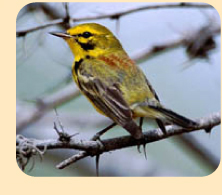 |
|||
|
|
|||
|
 What Species: Overwintering Neotropical migrants, including Ovenbird (Seiurus aurocapillus), American Redstart (Setophaga ruticilla), Black-throated Blue Warbler (Dendroica caerulescens), Common Yellowthroat (Geothlypis trichas); and permanent residents, including Black-crowned Palm-Tanager (Phaenicophilus palmarum), Green-tailed Ground-Tanager (Microligea palustris), Greater Antillean Bullfinch (Loxigilla violacea), and others. What Species: Overwintering Neotropical migrants, including Ovenbird (Seiurus aurocapillus), American Redstart (Setophaga ruticilla), Black-throated Blue Warbler (Dendroica caerulescens), Common Yellowthroat (Geothlypis trichas); and permanent residents, including Black-crowned Palm-Tanager (Phaenicophilus palmarum), Green-tailed Ground-Tanager (Microligea palustris), Greater Antillean Bullfinch (Loxigilla violacea), and others.
Where: Mencia, Pedernales Province, Dominican Republic; in the buffer zone of the Sierra de Bahoruco National Park. Who: Dr. Steven Latta (National Aviary), Danilo Mejía and Marisabel Paulino (Sociedad Ornitológica de la Hispaniola). When: 2003 – present Why: Birds throughout the world are threatened by habitat change. On the northern breeding grounds, as well as tropical wintering sites, migratory birds face a variety of degraded habitats. Agricultural lands, scrub, and early-successional forests represent a large majority of available habitats in many regions. Yet, much of the published work on wintering migrants (as well as Caribbean residents) has focused on birds in mature, native, and presumably optimal habitats. The question of how migrants and other birds respond to these early-successional habitats, and the impact of habitat degradation on avian demography, should be of high interest to avian conservationists concerned with population trends. Current Goals: (1) Determine relative abundance of migrant species occurring in early-successional habitats of 2, 5 10, and 20 years post-clearing, as well as in mature dry forest; (2) Describe the demographic structure of migrant populations in each habitat; (3) Determine body condition, overwinter site fidelity, and annual return rates for populations in each habitat; and (4) Use these data to assess habitat quality, winter population limitation, and the conservation implications of habitat change. Next Steps: Field work for this five-year study was completed in 2008. Page 2 
|



